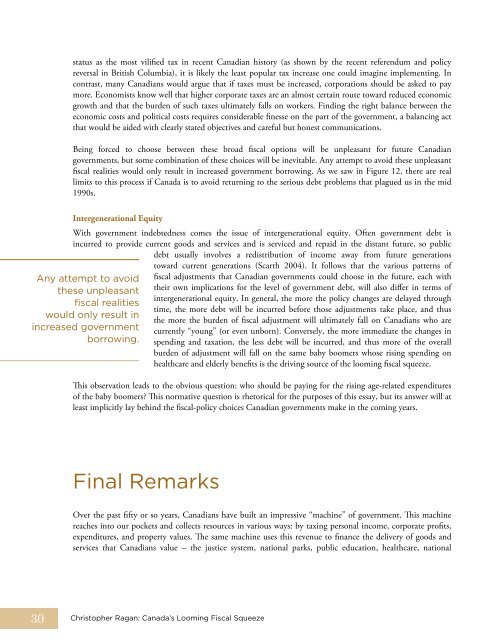Christopher Ragan, "Canada's Looming Fiscal Squeeze," November
Christopher Ragan, "Canada's Looming Fiscal Squeeze," November
Christopher Ragan, "Canada's Looming Fiscal Squeeze," November
Create successful ePaper yourself
Turn your PDF publications into a flip-book with our unique Google optimized e-Paper software.
30<br />
status as the most vilified tax in recent Canadian history (as shown by the recent referendum and policy<br />
reversal in british Columbia), it is likely the least popular tax increase one could imagine implementing. In<br />
contrast, many Canadians would argue that if taxes must be increased, corporations should be asked to pay<br />
more. economists know well that higher corporate taxes are an almost certain route toward reduced economic<br />
growth and that the burden of such taxes ultimately falls on workers. Finding the right balance between the<br />
economic costs and political costs requires considerable finesse on the part of the government, a balancing act<br />
that would be aided with clearly stated objectives and careful but honest communications.<br />
being forced to choose between these broad fiscal options will be unpleasant for future Canadian<br />
governments, but some combination of these choices will be inevitable. Any attempt to avoid these unpleasant<br />
fiscal realities would only result in increased government borrowing. As we saw in Figure 12, there are real<br />
limits to this process if Canada is to avoid returning to the serious debt problems that plagued us in the mid<br />
1990s.<br />
Intergenerational Equity<br />
With government indebtedness comes the issue of intergenerational equity. often government debt is<br />
incurred to provide current goods and services and is serviced and repaid in the distant future, so public<br />
debt usually involves a redistribution of income away from future generations<br />
toward current generations (Scarth 2004). It follows that the various patterns of<br />
Any attempt to avoid<br />
these unpleasant<br />
fiscal realities<br />
would only result in<br />
increased government<br />
borrowing.<br />
fiscal adjustments that Canadian governments could choose in the future, each with<br />
their own implications for the level of government debt, will also differ in terms of<br />
intergenerational equity. In general, the more the policy changes are delayed through<br />
time, the more debt will be incurred before those adjustments take place, and thus<br />
the more the burden of fiscal adjustment will ultimately fall on Canadians who are<br />
currently “young” (or even unborn). Conversely, the more immediate the changes in<br />
spending and taxation, the less debt will be incurred, and thus more of the overall<br />
burden of adjustment will fall on the same baby boomers whose rising spending on<br />
healthcare and elderly benefits is the driving source of the looming fiscal squeeze.<br />
This observation leads to the obvious question: who should be paying for the rising age-related expenditures<br />
of the baby boomers? This normative question is rhetorical for the purposes of this essay, but its answer will at<br />
least implicitly lay behind the fiscal-policy choices Canadian governments make in the coming years.<br />
Final Remarks<br />
over the past fifty or so years, Canadians have built an impressive “machine” of government. This machine<br />
reaches into our pockets and collects resources in various ways: by taxing personal income, corporate profits,<br />
expenditures, and property values. The same machine uses this revenue to finance the delivery of goods and<br />
services that Canadians value – the justice system, national parks, public education, healthcare, national<br />
<strong>Christopher</strong> <strong>Ragan</strong>: Canada’s <strong>Looming</strong> <strong>Fiscal</strong> <strong>Squeeze</strong>





